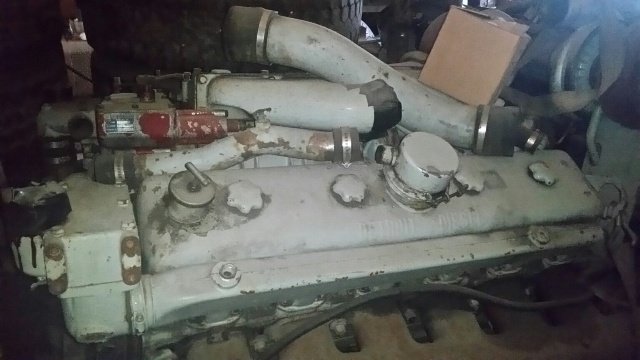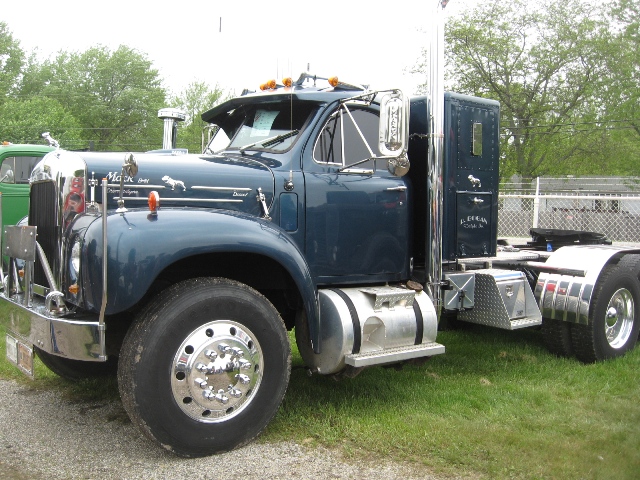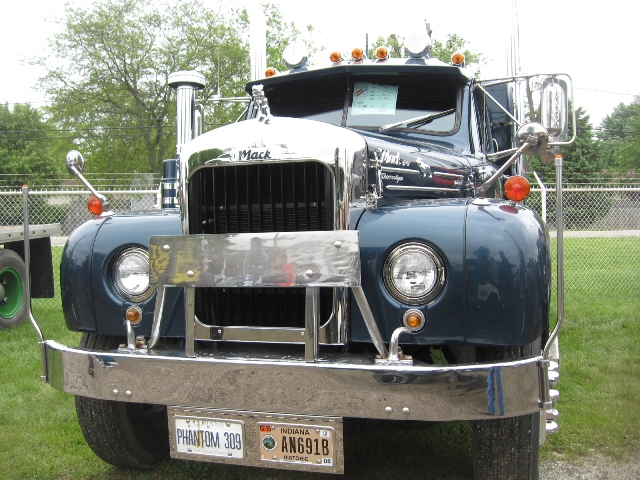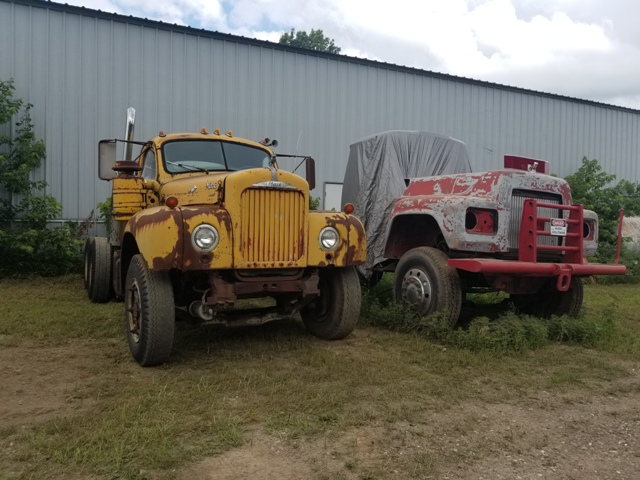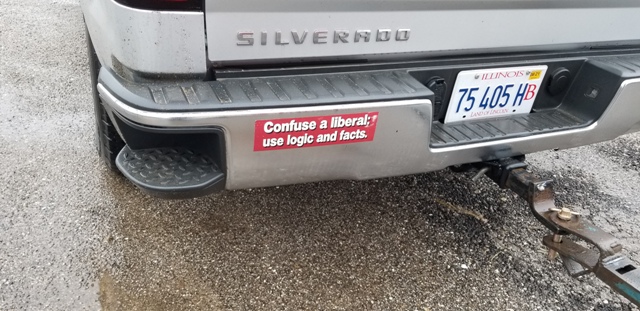-
Posts
12,753 -
Joined
-
Last visited
-
Days Won
175
Content Type
Profiles
Forums
Gallery
Events
Blogs
BMT Wiki
Collections
Store
Everything posted by Rob
-
Hi Glenn; I'm going to use the pump from the former military engine I have which is now rebuilt on that engine eventually. This is that engine we worked with many years ago, (ENDT673B) on a stand in the shop. It's not been run since the rebuild and does have the oil drainback connection for the turbocharger. I may install it's induction system if it will clear too as another option. I've still not converted this engine to standard flywheel housing or any of the like and it sets bolted to the same stand.
-
I always favored the 12V-71T myself although have never driven one on the road. Worked on several and have one for my own truck someday I'd saved from work. They were so versatile and easy to get parts for. They still are pretty easy to get parts for too.
-
Back in the mid 1970's when I was a young guy and the 711 engines were still fairly plentiful, they had a tendency to be hard on the exhaust valves and I was grinding sets a couple times a month for different trucks with my trusty "Sioux" seat and valve grinding set. Certainly did a lot of them starting out and always had a spare set of heads ready to go. A lot of those engines didn't make 100K miles before the heads had to come off..... My thoughts followed Mack engineering by installing a low pressure turbocharger onto those engines and they would yield a good long service life, and a little more power. My B61S has a Mack factory upgraded induction system with this type turbocharger installed. It may make 5-6psi of boost but the point is the valves on that engine needed cooling air and this supplied it. It has run a lot of miles in the years and the chassis is no longer roadworthy, but the engine runs perfect. I've seen guys simply bolt on a 237 turbocharger and manifold onto 673's, and 711's and have good service, and seen some scatter the engines shortly afterward. In fairness, a guy running his own truck usually fared better where employees, well..... Blown 237's used to be almost as common as dirt so parts were easy to come by but I don't know about nowadays as have been away from truck repair a lot of years now. Anybody can do whatever they want of course but I have a 58 B-61ST which has it's original 673 engine and I'm going to install a 237 induction system onto it and keep the original triplex to make use of the truck someday. I am going to regear it to 3.65 ratio from the current 5.05 to get the road speed up into the modern era. I'm the second owner of that one so wanting to keep it close to original in appearance.
-
Seen this done several ways in years gone by. My 64 B-61S, (Yellow Dog) has a 711 which has been turbocharged and runs like a scalded dog. This is the mule I was monkeying with several years ago swapping turbos, injection pumps and calibrations, and the like to get 300hp from and I did but kept popping head gaskets on the chassis dyno. The heads are now scored with a later fire ring head set installed so it would probably be alright to run, but there is no charge air cooling and the exhaust would heat quickly if the throttle were held to it. As you know a 237 is about as close to a slip fit as you're going to get with just a few donor parts which you mostly have. A 300+ will only benefit you if planning to work the truck above what a 237 engine will provide in my opinion. If just running around as a casual use vehicle, the 237 engine will provide plenty of power. Recalibrating the injection pump is a matter of preference. I've done both. Again if working the truck it is beneficial to have the conventional torque rise apply if the truck is working given the limitations of the existing driveline, and really won't matter much if a casual use vehicle. A 300+ engine will fit into the truck but is snug. Ron Bogan whom used to be a participant here, (B61 Mack IIRC) has either a 300+, or an ENDT-676 installed into his and it fits nicely. I've looked the truck over quite extensively and it fits well, but is tight. To work on much of anything in the B series you are going to take things apart and the 300+ hardware is not a high maintenance item, so shouldn't be too much of a concern. Ron has air conditioning on his and modified the front shutters to allow a condenser coil installation behind them, and in front of the radiator. I know I have engine photos but cannot find them.
-

Engine colour
Rob replied to Licensed to kill's topic in Antique and Classic Mack Trucks General Discussion
In reality I like just about any color with chromed, or aluminum rocker covers if not black, or red wrinkle finish. My personal preference is dark machine gray with chromed rocker covers on a Mack engine which is what is in my B-61. -

Engine colour
Rob replied to Licensed to kill's topic in Antique and Classic Mack Trucks General Discussion
I look at it this way. "You" only have to please the owner. -

B61 Removal of Rear Leaf Springs
Rob replied to thomastractorsvc's topic in Driveline and Suspension
I made a deep receiving socket from a piece of 2" round stock and used a very large "C" clamp years ago. I subsequently replaced the clamp with a 2" push port o power cylinder and will still use it if needed. Just have to stack nuts inside the cavity vacated by the pin as it's pushed free. Otherwise yes, remove the spring hanger. While that pin is out, ensure that hole on both ends is still round as I've seen them worn elliptical. -
I usually don't answer the phone any longer unless I know the person calling. Most I have shoot me a text, or email and I call them back as there is no limit on data, or internet usage. The phone ringer is turned down or off, and the "notifications" annunciator is enabled so this works well and is not distracting.
-
REI is a very consistent rebuilder and I've used them several times. Nice folks too if you visit them. EPDM rubber does not fare well when in contact with engine oil and readily swells, softens, and/or splits. It is the rubber the diaphragms, and piston cups are molded from in the aforementioned failing parts. With a failed air compressor one is best to remove and flush the discharge line from the air compressor to the air dryer or wet tank, and the wet tank at least as this is where most of the "tramp oil" will accumulate.
-
Well shit. I feel left out with no offering to be offended given my soft and sensitive style.
-
I've only seen that type offset grille on one other truck and it was also an ENDT-676 powered RS-686. It was either a 78, or 79 model year truck.
-
I have wedge brakes on a 74 RL797 and they will stick you in the glass if applied hard, but do require maintenance which most did not get rendering their bad reputation. Hard to get parts easily for any longer too as not much available over the counter.
-
Sure wore engines out fast when used that way too.....
-
Inverted Camelback is what it was called and used to see it a lot in the early 80's. Can't put a number on how many fleet tractors the company I was working for converted to tandem dumps and swapped this suspension to a regular 38K Camelback setup. Most was well worn when it came into the shop, but I'd never seen an accident attributed to it's breakage myself. The suspension itself did ride very good, but didn't render long service life before requiring repairs in end dump work. Standard Camelback went much longer between service intervals.
-

Need help identifying Mack Dump Truck please?
Rob replied to IH Tom's topic in Modern Mack Truck General Discussion
And quite easy to get a lot of power from relatively inexpensively. Nothing smoother on diesel engine generator duty than a two stroke Detroit Diesel. -
Happens all the time.....
-
Damn, I thought I was the only one and she really, really, wanted me.....
-
UHF, VHF used for video and television communications are "Line of Sight" frequencies so vertical height is a must for distant reception. Doesn't matter if the component is digital, or analog, it is still carried by a frequency in the aforementioned "bands" for transmission. This "carrier frequency" is then stripped off and useful intelligence remains. This is then heterodyned into it's component parts and an intermediate frequency is generated for further processing into what you see on your screen. However if the carrier is not strong, there is no intelligence available which by the way is my personal dilemma..... Get your 3 sided antenna array up to about 75 feet vertical, use good cables, interconnections, and high quality components and you'll be happy. Be certain to environmentally seal the interconnections for your continued happiness.
-
Inexpensive antennas will receive everything in the frequency spectrum. Antennas designed to pass only the frequency band allocated to television signals strip off anything outside of this frequency band of signals. 50 ohm impedance cable is better than 75 ohm impedance cable for passing signals in the rf spectrum. 75 ohm impedance is the "apparent" resistance video manufacturer's standardized upon many years ago for distribution. To further muddy the waters, if you use a higher impedance cable than required, received signal strength is considerably reduced and you will see this as "static", or "white noise" on your monitor. In these days of everything digital, it usually is just a blank screen. Again my suggestion would be to incorporate three high gain antennas and parallel their respective outputs into a single serial output, install an amplifier to boost the received signals, balance the circuit loading through an impedance changing network, and feed it to your video distribution network. All of this is easily obtained at a video store and really not all that expensive. The key is that it is much easier to work with a strong received signal than a weak on. This starts with the antenna(s). This received information needs boosted for additional functions and stripping off the unneeded components of the signal for further processing. Much of this will be taken care of via your converter box, or tuner in the television. It however must have good signals to start with and this begins with quality antennas and interconnections of wiring.
-
Your door hinge and floor flange are a great improvement to your existing design. If'n it were me and I was wanting to receive all the stations in the area I would purchase three high gain antennas and mount them 120 degrees apart at the top of the mast. From these antenna output jacks, parallel their received outputs into a single unit. Also purchase an "Impedance Changer" from an online supplier to change the 50 ohm terminations to 75 ohm and run a heavier gauge RG-75 video cable to your distribution network inside the house. Better yet would be to bring the received signal down into the house through a 50 ohm RF series cable, (RG-214) for a very low loss transmission rate and use the impedance changer near the point of use meaning your video distribution apparatus. I do not care for the customary "F" series cable terminations commonly used on household video cables but rather "TNC, or BNC" style which are much better quality. TNC is threaded, BNC is bayonet style mounting to the female jack.
BigMackTrucks.com
BigMackTrucks.com is a support forum for antique, classic and modern Mack Trucks! The forum is owned and maintained by Watt's Truck Center, Inc. an independent, full service Mack dealer. The forums are not affiliated with Mack Trucks, Inc.
Our Vendors and Advertisers
Thank you for your support!





